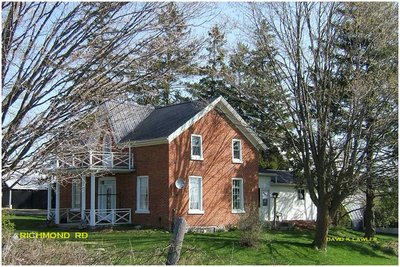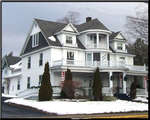Herrington Farm, 395 Richmond Street, Brighton, Ontario
Description
- Media Type
- Image
- Text
- Description
- Historical Name: Herrington Farm
Location of Property: 395 Richmond Street, Brighton, Ontario
Legal Description: Concession 5 S Part Lot 5
Description: House
Date of Construction: 1810
Heritage Status: Listed
Summary of Cultural Attributes:
The Herrington farm north of Hilton was acquired by Lloyd Herrington in 1918. His grandfather, William Herrington, had moved from Hillier Township to a farm northeast of Hilton in 1841 to establish the family in the area. Land records described Lloyd Herrington’s land as the south 90 acres of lot 4, concession 5, Brighton Township. The property had several previous owners, but the longest tenure was Robert Potts who acquired it in 1862 from Richard Stephens. The Potts family farmed here until 1901 when it was sold to Burton Philp. It was probably during this period, most likely in the 1870s, that the brick house we see today was built.
Background:
The earlier history of this property is confusing. The Patent from the Crown went to Robert Q. Short, a minister who came from England around 1796 and worked in Kingston before settling his family in Trois-Riviere, Quebec. His position allowed him to obtain 1,200 acres in land grants in Cramahe Township, including several lots in concession 5. He never lived here, but his land grants would fund the next generation of his family as lots were sold to people who wanted to settle on the land.
One of Robert Q. Short’s sons, William, would reside on part of the land his father had acquired, and his son James Short farmed the north half of lot 4, concession 5, being the best known of that family in the Hilton area through the 1880s.
The south 90 acres of lot 4, concession 5 was sold to Richard Stephens in 1824. He had been in the area for a few years, and had purchased land in Murray, but soon established his growing family in Cramahe Township, at the intersection of The Percy Road and the concession line road. The small village of Hilton would develop around this intersection. In the 1840s, parts of the Stephens land would pass to Richard’s sons as they married and had families of their own.
This all changed dramatically on April 21, 1852 when the small lake north-west of Hilton broke through the gravel bank and cascaded down the narrow valleys to the east. Known as The Breakaway, this event would become local lore, discussed at the kitchen table and while driving with grandparents for generations to come.
The practical outcome for the Stephens family was that an important part of their property on the south side of the lake had been significantly damaged. The result was that, within the next few years, they would divest themselves of land in this area and move to Kent County where they established a thriving agricultural enterprise. They were done with Hilton.
Robert Potts took advantage of this sale of land, as did several others in the area.
Source: Dan Buchanan
Architectural:
The red brick with white trim, 1 3/4 storey house is typical Ontario 19th century Gothic Cottage style - a rectangular shape with a central wide front entrance topped by a peaked gable with a gothic window below, believed to be the original. The lower floor doors and windows have a slight arch in the over brick.
Today the farm has a second house with a separate number, built in 1965, and 11 outbuildings.
Sources: MPAC; OLR Records.
- Publisher
- Municipality of Brighton Register of Properties of Cultural Heritage Value or Interest
- Subject(s)
- Local identifier
- abdap_munb-042
- Language of Item
- English
- Copyright Statement
- Copyright status unknown. Responsibility for determining the copyright status and any use rests exclusively with the user.
- Contact
- Brighton Digital ArchivesEmail:brightondigitalarchives@gmail.com
Agency street/mail address:Brighton Public Library
35 Alice Street
P.O. Box 129
Brighton, ON K0K 1H0



